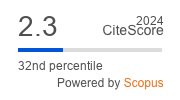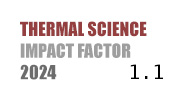THERMAL SCIENCE
International Scientific Journal
EFFECT OF PRIME MOVER REGENERATOR RADIUS ON THE PERFORMANCE AND CHARACTERISTIC OF ACOUSTIC FIELD OF THERMOACOUSTIC REFRIGERATOR DRIVEN BY PRIME MOVER
ABSTRACT
Refrigerated truck is indispensable transportation for food and medicine. However, the truck has been using the harmful substance such as CFC or HCFC. Therefore, an alternative cooler is essential such as thermoacoustic refrigerator. The refrigerator is driven by the thermoacoustic heat engine (prime mover), so the prime mover can convert the thermal or waste heat into the acoustic energy for driving the refrigerator. There are some parameters that can improve the efficiency of the refrigerator system. The aim is to investigate the impact of prime mover regenerator radius on the efficiency and characteristic of acoustic field. It was found that the best performance of the whole refrigeration system was achieved when the radius is 0.68. The engine and cooler efficiency are 84% and 38%, respectively. In addition, the acoustic field characteristic was also analyzed to elucidate the mechanism in the refrigerator system.
KEYWORDS
PAPER SUBMITTED: 2023-04-23
PAPER REVISED: 2023-09-18
PAPER ACCEPTED: 2023-09-27
PUBLISHED ONLINE: 2023-11-11
THERMAL SCIENCE YEAR
2024, VOLUME
28, ISSUE
Issue 2, PAGES [1837 - 1848]
- Marshall, R., et al., (Cambridge Refrigeration Technology), Energy Usage During Refrigerated Transport, Tech. Doc. prepared for the School of Eng. and Design, Brunel University, London, UK, 2006
- Tassou, S. A., et al., Food Transport Refrigeration - Approaches to Reduce Energy Consumption and Environmental Impacts of Road Transport, Applied Thermal Engineering, 29 (2009), 8-9, pp. 1467-1477
- Gielen, D., et al., Global Renewables Outlook: Energy Transformation 2050, International Renewable Energy Agency, Abu Dhabi, UEA, 2020
- Dong, Y,. et al., Greenhouse Gas Emissions from Air Conditioning and Refrigeration Service Expansion in Developing Countries, Annu. Rev. Environtment Resour., 46 (2021), 1, pp. 59-83
- Sprous, C., Depcik, C., Review of Organic Rankine Cycles for Internal Combustion Engine Exhaust Waste Heat Recovery, Appl. Therm. Eng., 51 (2013), 1-2, pp. 711-722
- Aghaali, H., Angstrom, H, E., A Review of Turbocompounding as a Waste Heat Recovery System for Internal Combustion Engines, Renew. Sustain. Energy, 49 (2015), Sept., pp. 813-824
- Zhou, J., M. et al, Study of Thermoacoustic Engine for Automotive Exhaust Waste Heat Recovery, SAE Technical Paper Series, 2019-01-1257, 2019
- Jin, T., Application of Thermoacoustic Effect to Refrigeration, Rev. Sci. Instrum., 74 (2003), 1, pp. 677-679
- Rokhmawati, E. D., et al, Numerical Study on the Effect of Mean Pressure and Loop's Radius to the Onset Temperature and Efficiency of Travelling Wave Thermoacoustic Engine, AutomotiveExperiences, 103 (2020), 2, pp. 96-103
- Farikhah, I., et al, Numerical Study on the Effect of Stack Radii on the Low Onset Heating Temperature and Efficiency of 4-Stage Thermoacoustic Engine, Arab. J. Sci. Eng., 48 (2022), June, pp. 2769-2778
- Farikhah, I., et al., Thermoacoustic Design Using Stem of Goose Down Stack, Proceedings, American Institute of Physics (AIP), 19th International Symposium on Nonlinier Acoustic (ISNA 19), Tokyo, Japan. 1474, 2012, pp. 283-286
- Chen, G., et al., Modelling and Analysis of a Thermoacousticpiezoelectric Energy Harvester, Appl. Therm. Eng., 150 (2019), Mar., pp. 532-544
- Ueda, Y., Farikhah, I., Calculation of Energy Conversion Efficiency of a Stack-Screen Stack Using Ther-moacoustic Theory, TEION KOGAKU (Journal of Cryogenics and Superconductivity Society of Japan), 51 (2016), 8, pp. 403-408
- Utami, S. W., et al., Numerical Study of the Influence of Radius Regenerator on Thelow Heating Tem-perature and Efficiency of Travelling Wavethermoacoustic Engine, Proceedings, J. of Physics: Conf. Se-ries, Madiun, Indonesia, 2020., vol. 1464, pp. 1-6
- Ueda, Y., Kato, C., Stability Analysis of Thermally Induced Spontaneous Gas Oscillations in Straight and Looped Tubes, J. Acoust. Soc. Am., 124 (2008), 2, pp. 851-858
- Swift, G., Backhauss, S., A Thermoacoustic Stirling Engine: Detailed Study, J. Acoust. Soc. Am., 107 (2000), 6, pp. 3149-3150
- Yazaki, T., et al., Travelling Wave Thermoacoustic Engine in a Looped Tube, Phys. Rev. Lett., 81 (1988), Oct., pp. 3128-3131
- Farikhah, I., et. al., Study of Stack Length on Efficiency of Thermoacoustic Engine, Proceedings, 3rd IEEE Eurasia Conference on IOT, Communication and Engineering 2021, Yunlin, Taiwan, 2021, pp. 580-582
- Farikhah, I., Ueda, Y., The Effect of the Porosity of Stacks on the Performance of a Heat-Driven Thermo-acoustic Cooler, Proceeding, 24th Int. Con. on Sound and Vibration (24 ICSV) London, 2017, pp. 1-8
- Farikhah, I., Ueda, Y., Numerical Calculation of the Performance of a Thermoacoustic System with En-gine and Cooler Regenerators in a Looped Tube, Appl. Sci, 7 (2017), 7, pp. 1-14
- Yang, R., et al., Performance Optimization of the Regenerator of a Looped Thermoacoustic Engine Pow-ered by Low-Grade Heat. Int J Energy Res., 42 (2018), 14, pp. 4470-4480
- Yazaki, T., et al, A Piston-Less Stirling Cooler, Appl. Phys. Lett., 80 (2002), 1, pp. 157-159
- Jin, T., et al., Acoustic Field Characteristics and Performance Analysis of a Looped Travelling-Wave Thermoacoustic Refrigerator, Energy Conversion and Management, 123 (2016), Sept., pp. 243-251
- Swift, G. W., Thermoacoustic Engines, J. Acoust. Soc. Am., 84 (1988), 4, pp. 1159-1160
- Ueda, Y., et. al., Acoustic Field in a Thermoacoustic Stirling Engine Having a Looped Tube and Resona-tor, Applied Physics Letter, 81 (2002), 27, pp. 5252-5254

